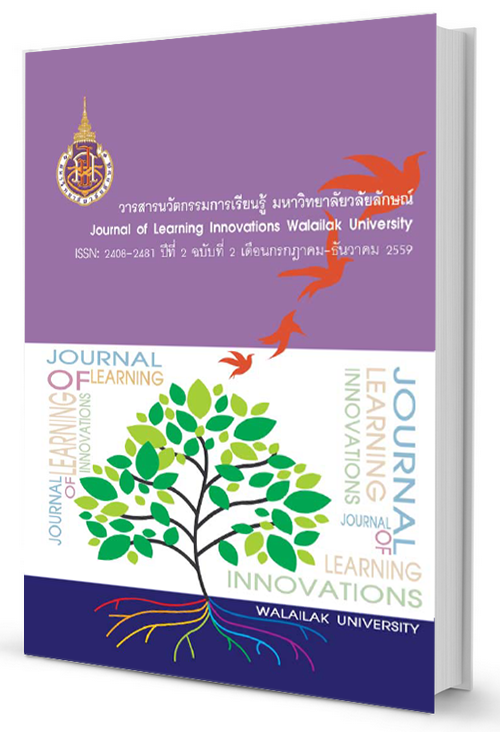Language Learning Strategies Used by International Students in Learning the Thai Language
Keywords:
language learninge strategies, Walailak University international students, Thai language learningAbstract
This study investigated the language learning strategies used by international students who had different language backgrounds in learning the Thai language at Walailak University. This case study was administered after the students completed an intensive course on the Thai language conducted by the university. This class was solely for the 10 international students who wished to develop their Thai basic communication skill for the purpose of interacting with Thais around them. The qualitative data were collected from each participant in a one-to-one interview. The results from the 10 interviews showed that the students preferred to use three language learning strategies, namely 1) the use of L1 translation to the target language, 2) thinking in the target language, such as remembering specific words, sentences, and expressions and 3) practicing with the local people who can speak English.
References
Chamot, A., & O'Malley, M. (1996). Implementing the cognitive academic language learning approach (CALLA). เท R. Oxford (Ed.), Language learning strategies around the world: Cross-cultural perspectives (pp. 167-173). Honolulu, University of Hawaii, Second language teaching and curriculum center.
Craik, F.I.M., &Tulving, E. (1975). Depth of processing and the retention of words in episodic memory. Journal of Experimental Psychology: General, 104, 268-294.
Green, J. M., and Oxford, R. L. (1995). A closer look at learning strategies, L2 proficiency, and gender. TESOL Quarterly 29(2), 261-297. Bachman, L. F. & Palmer, A. S. (1996). Language testing in practice. Oxford: OUP.
Hakan, K., Aydin, B., & Bulent, A. (2015). An Investigation of Undergraduates’ Language Learning Strategies. Procedia - Social and Behavioral Sciences, 197, 1348-1354. https://doi.Org/10.1016/j. sbspro.2015.07.388
Holec, H., (1981). Autonomy and Foreign Language Learning. Pergamon Press, Oxford.
Kayi., Hayriye (2006). Teaching Speaking: Activities to Promote Speaking in a Second Language, The Internet TESL Journal, Vol XII, No. 11, November 2006. https://iteslj.org/Articles/Kayi-Teaching Speaking, html. p. 1 - 2
Krippendorff, K. (2004). Content analysis: An introduction to its methodology (2nd ed.). Thousand Oaks, CA: SAGE Publications.
McKeown, M.G. 1993. Creating effective definitions for young word learners. Reading Research Quarterly 28, 1: 17-31
Rajprasit, K., Pratoomrat, p., Wang, T., Kulsiri, พ., & Hemchua, ร. (2014). Use of the English language prior to and during employment: Experiences and needs of Thai novice engineers. Global Journal of Engineering Education, 16(1), 27-33.
Srikaew, D., Tangdhanakanond, K., & Kanjanawasee, ร. (2015). Development of an English Speaking Skill Assessment Model for Grade 6 Students by Using Portfolio. Procedia - Social and Behavioral Sciences, 191, 764-768.
https://doi.Org/10.1016/j.sbspro.2015.04.715 Stern, H.H., (1975). What can we learn from the good language learner?
Canadian Modern Language Review 31, 304-318.
McDonough, S. (1995). strategy and Skill in Learning a Foreign Language. London: Edward Arnold.
Nation, l.s.p. (2001). Learning Vocabulary in Another Language.Cambridge: Cambridge University Press.
Nunan, D. (2010). Teaching English to young learners. Anaheim: Anaheim University Press.
Rubin, J., (1987๗. Learner strategies: Theoretical assumptions, research history and typology. in:
O’Malley, J., Chamot, A., (1990). Learning Strategies in Second Language Acquisition. Cambridge University Press, Cambridge.
Oxford, R (2011). Teaching & researching: Language learning strategies (applied linguistics in action). Pearson ESL, England.
Wang, S. (1996). A study of Chinese English majors’ beliefs about language learning and their learning strategies. Dissertation Abstracts International, 57(12), 5021A. (UMI No. 9716564).
Wenden, A., (1987). How to be a successful language learner: Insights and prescriptions from L2 learners. เท: Learner Strategies in Language Learning. Prentice/Hall International, Englewood Cliffs, NJ, pp. 103-118.
Downloads
How to Cite
Issue
Section
License
เนื้อหาและข้อมูลในบทความที่ลงตีพิมพ์ในวารสารนวัตกรรมการเรียนรู้ มหาวิทยาลัยวลัยลักษณ์ ถือเป็นข้อคิดเห็นและความรับผิดชอบของผู้เขียนบทความโดยตรง ซึ่งกองบรรณาธิการวารสาร ไม่จำเป็นต้องเห็นด้วย หรือร่วมรับผิดชอบใดๆ
บทความ ข้อมูล เนื้อหา รูปภาพ ฯลฯ ที่ได้รับการตีพิมพ์ในวารสารนวัตกรรมการเรียนรู้ มหาวิทยาลัยวลัยลักษณ์ ถือเป็นลิขสิทธิ์ของวารสารนวัตกรรมการเรียนรุ้ มหาวิทยาลัยวลัยลักษณ์ หากบุคคลหรือหน่วยงานใดต้องการนำทั้งหมดหรือส่วนหนึ่งส่วนใดไปเผยแพร่ต่อเพื่อกระทำการใดๆ จ้อต้องได้รับอนุญาตเป็นลายลักษณ์อักษรจากวารสารนวัตกรรมการเรียนรู้ มหาวิทยาลัยวลัยลักษณ์ก่อนเท่านั้น


